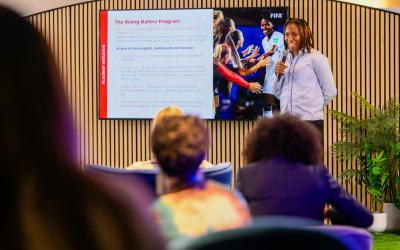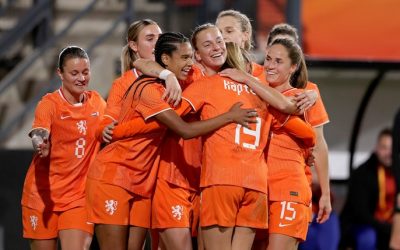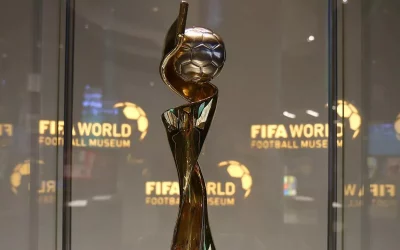While its powers have waned in recent years , the USWNT has long enjoyed status as tormentor-in-chief to Europe’s elite women’s football teams.
This success has often been put down to the strength of the USA’s domestic competition, the National Women’s Soccer League (NWSL). It is currently ranked second-best to the WSL.
Nations like Brazil have long tried to oust the Stars and Stripes as Europe’s main rival – but to no avail; their poor domestic league, ranked 30th, has been mooted as a leading factor.
Every FIFA Women’s World Cup since 1991 has been won by USA or a European nation, with one exception: Japan.
Japan were crowned world champions in 2011. They defeated Sweden and Germany on their way to the final before beating the USA on penalties.
Now, the East Asian nation hopes to return to its former glories and it has a domestic league that it believes will help blaze the right trail – in more ways than one.

The WE League
Established in July 2020 before officially launching the following year, Japan’s premier women’s division is now the WE League.
WE stands for “Women’s Empowerment”.
It supersedes its predecessor, the semi-professional Nadeshiko League, in more ways than one. Japan’s first fully professional women’s league is not just about empowering women on the pitch either.
It operates with strict inclusion policies, international collaborations, and a commitment to empowering women in sports and beyond.
WE League makes no bones about the fact that its mission stretches high and wide. It aims not only to promote gender equity, help further stablish professional women’s sports in Japan and grow women’s football in the country, but to explicitly reclaim the world championship for Japan’s national team.
Player consultation
Furthermore, clubs’ workforces must reflect these goals directly. Within three years of forming, WE League chairwoman Kikuko Okajima expects at least 50% of staff to be female. If clubs fail to meet this criteria they face sanctions and, ultimately, the risk of expulsion.
Clubs must also have at least one female executive in decision-making roles as well as an “Empowerment Department” officer.
There is protection for players by way of a minimum wage of 2.7 million JPY for all players and a minimum home stadium capacity of at least 5,000 – childcare facilities must be available at all stadiums too.
innovative approach
The league already has DAZN signed up as its official broadcaster on an eight-year deal as well as commercial agreements with Web Shark, Daihatsu, Asahi Kasei, Reckitt Benckiser, Persol Holdings and Molten.
What makes the different is its commitment to making sure women are key to the league’s success. In consultation with the players, the league has WE League credo, a player-driven code of conduct emphasizing leadership and commitment.
The league says this “summarises the desires and commitments of all WE League players to become future leaders and role models” as well as enable players to “give back to their fans, supporters, the local community and society through football.”
The league follows a home-and-away double round-robin system, meaning a single season consists of 110 matches. Up for grabs is the “Women Empowerment Trophy” – a unique glass trophy symbolising the leagues commitment to breaking gender barriers.

World-leading practices
The WE League has plans to quickly become and remain a key player on the global stage.
In a bid to attract the best talent available, the league offers financial support to teams that want to recruit players from other Southeast Asian countries as well as established international names from Europe, America and beyond.
It has also signed Women’s Empowerment Principles (WEPs) in partnerships with the UN Global Compact & UN Women. The JFA also signed the principles, making JFA and the WE League the only two Japanese domestic sports organisations to have done so.
The league already has ground-breaking memorandums of understanding with La Liga as well as the other leagues in the Japanese pyramid, the Nadeshiko League. These memorandums ensure cooperation and knowledge-sharing in a number of areas, with the aim of further developing women’s club football worldwide.
Partnership with JICA, JFA and the J.League are also in place to develop football in emerging regions.
So what next?
While the hard work is clearly still to come, it is impossible not to admire what has already been done.
The next task is to get the ball rolling, clearly. In its inaugural season, 11 teams participated and INAC Kobe Leonessa finished top in May as Urawa Red Diamonds finished second.
In the two subsequent full seasons, it was a tale of opposites as Urawa Red Diamonds won both leagues in 2023 and 2024 as INAC Kobe Leonessa were twice runners-up.
Last season, Cerezo Osaka Yanmar joined to form a 12-team league. The next challenge is to acquire the right talent to lift the league up from it’s current standing as 20th in the world.
The hope is that once that is done, Japan’s national side will lift itself above the likes of Brazil, Canada and Sweden and challenge the world’s top five nations.
Just how soon that comes about notwithstanding, women’s football in Japan looks to have a bright and successful future.



